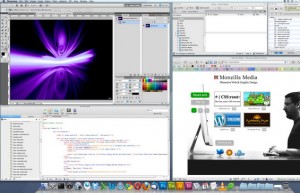The secret to Batch Ranking
 If youÕre using PhotoshopÕs handy File Browser, you probably already know that it allows you to rank images to help you sort and organize them. However, what if you need to rank 50 or 60 images all the same? Do you have to go to 50 or 60 images individually and rank them one-by-one? It would seem so, because thereÕs nothing in the drop-down palette about it, but hereÕs the little secret tip that will make all your dreams come true (okay, itÕs something short of that, but itÕs a good tip). First Shift-click on all the images you want to rank, and then Control-click on one of them to bring up the contextual menu. Choose Rank and then type in the rank you want to use in the Rank Files dialog, and it will automatically rank every file you chose. Thanks to AdobeÕs Graphics Evangelist Julieanne Kost for sharing this cool inside tip.
If youÕre using PhotoshopÕs handy File Browser, you probably already know that it allows you to rank images to help you sort and organize them. However, what if you need to rank 50 or 60 images all the same? Do you have to go to 50 or 60 images individually and rank them one-by-one? It would seem so, because thereÕs nothing in the drop-down palette about it, but hereÕs the little secret tip that will make all your dreams come true (okay, itÕs something short of that, but itÕs a good tip). First Shift-click on all the images you want to rank, and then Control-click on one of them to bring up the contextual menu. Choose Rank and then type in the rank you want to use in the Rank Files dialog, and it will automatically rank every file you chose. Thanks to AdobeÕs Graphics Evangelist Julieanne Kost for sharing this cool inside tip.
Brush changes update in two places at once
Now that Photoshop has brushes available to you in two places (from the Options Bar and from the floating Brushes palette) you’d think that you’d have to go back and forth updating one or the other when you save or edit a brush. Luckily, Adobe designed it so changes you make in one palette are automatically carried through to the other palette, so that when you’re editing and creating brushes, fear not–the other palette will know what you’re doing and will be updated appropriately.
What’s in a name?
Adobe made a tiny change to a menu item that makes a whole lot of sense. To hide any of Photoshop’s visual indicators (such as type highlighting, the Free Transform bounding box, non-printing guides, Slice borders, etc.) you would choose Show Extras from the View menu. That’s right, to hide the extras, you’d choose Show Extras. It was one of those menu commands that really made you scratch your head. Adobe changed that, and now it’s just called "Extras." Either you want them or you don’t, and as always, a checkmark next to the menu item lets you know if it’s toggled on or off.
Speeding up Photoshop by merging layers
Photoshop is a slave to file size: the larger the size of your file, generally speaking, the slower Photoshop goes (especially if you’re short on RAM). Every time you add a layer, it significantly adds to the overall file size of your image. That’s why it’s sometimes a good idea to merge together layers that you don’t think you’ll need to adjust later on. For example, if you have ten layers of type, you can save a lot of file size by rasterizing each of the Type layers and merging them into one layer. Do this by clicking on the top text layer and pressing Command-E. This takes the layer you’re on and merges it with the layer directly beneath it. Keep pressing Command-E until all the text layers are merged. Your file size will shrink, and in many cases, Photoshop goes faster. Be careful when merging layers with Layer Styles applied, though, because they have Blend Modes assigned by default, and merging them can change or hide those effects.


No comments
Be the first one to leave a comment.